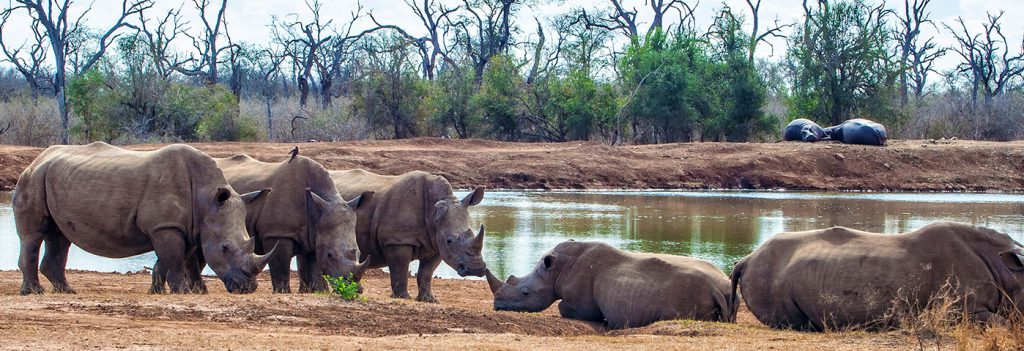If this is news to you, you must have been living under a rock for the last 6 years or so! Saving the Rhino’s has become a ubiquitous phrase for so many years not only in South Africa, but world-wide. Some have even gone so far as to label the campaign a symbolic quest for humans as a species. The number of organisations, charities, government initiatives etc. are overwhelming, and a good indication of humankind’s fascination with rhinos and their survival.
What is the current state of rhinos world-wide?
The threat to rhinos is not only prevalent to Africa – there are three Asian rhinos who are in the same sad state as their African cousins. The upcoming CITES Conference of the Parties (CoP18) World Wildlife Conference in Geneva, Switzerland this August, filed a report on the worldwide crisis of the 5 remaining species of rhino:
Greater one horned rhino or Indian Rhino
Once native to the entire Indo-Gangetic Plain (northern regions of the Indian subcontinent), the Indian rhino is now only found in 11 sites in Northern India and Southern Nepal. Listed as Vulnerable on the IUCN Red List, there are an estimated 3,588 individuals alive as of 2017.
Sumatran Rhino
These solitary rhinos once roamed the rain forests, swamps and cloud forest of India, Bhutan, Bangladesh, Myanmar, Laos, Thailand, Malaysia, Indonesia, and China. Now limited to Sumatra and Borneo, they are Critically Endangered on the IUCN Red List with a 2017 estimated 65-68 individuals left in the wild.
Javan Rhino
Considered to be possibly the rarest mammal on earth with an estimated population of 40-78, Javan Rhinos were once the most widespread of the Asian rhinos, from the islands of Java and Sumatra, throughout Southeast Asia, and into India and China. Critically Endangered on the IUCN Red List, there is only one known population left in Java. Their low numbers, habitat and shyness make them the least studied of the rhino species.
Black Rhinos
Calling Eastern & Southern Africa their home, Black rhinos are the most threatened rhino species in Africa. Whilst individual numbers seem to be high at an estimated 5,495 (2,046 in South Africa), they are listed as Critically Endangered on the IUCN Red List, due to the fact that 3 of the 8 sub-species have already been declared extinct and the Chobe black rhino is on the brink of extinction, with possibly only one surviving individual in Botswana.
White Rhino
The largest rhino and consisting of 2 sub-species, the northern and the southern white rhino, their habitat extended from East, Central and Southern Africa. Sadly, the northern sub-species is on the Critically Endangered IUCN Red List and is possibly Extinct in the Wild, as in 2018 only 2 confirmed individuals – both female – are in captivity in Kenya. Southern white rhinos, however, are the most abundant subspecies of rhinos in the world; last count in 2017, there are 18,067 (15,625 in South Africa) individuals.
Obviously, poaching, which I’ll talk about below, plays is the primary cause in the decline of rhino populations in both Africa and Asia, but there are other extenuating factors, which are common factors affecting most wildlife:
- Disappearing habitats to human settlements and agriculture
- Drought: in particular Southern Africa
- Poor diets leading to disease and low reproduction rates
- Low populations lead to a low amount of genetic diversity and increased inbreeding
On a more positive note, According to the CITES CoP18 rhino report, African rhino poaching is on the decline: from its highest point in 2014 at 1,324 rhinos to 1,124 in 2017, and they have predicted a new low of 937 in 2018 (this data is still to be released). Asian anti-poaching efforts have been more successful, even with the less rhinos then Africa, with 2013 at its highest point of 41 rhinos to 12 rhinos in 2017.
The greatest rhino successes are mirrored in both Africa and Asia, where government legislation and prosecution are combined with educating staff and effective action on the ground. Recently, there have been some criticism that not enough has been done to find alternative income for local African communities, who are the poachers. These communities are generally under the poverty line, and the lure of selling rhino horn at an estimated sales price of US$30 000 – US$50 000 per kg, is too high a price to ignore.
At WTM Africa we are committed to the conservation and preserving of our national wildlife, and of course, our rhinos. The Rhinos are Coming (TRAC), is a non-profit organisation to raise awareness and much needed funding for anti-rhino poaching organisations and campaigns in South Africa. TRAC was born out of the need to highlight the plight of our rhinos and utilizes the many benefits of public art for an incredible cause. Creating beautiful rhino statues in collaboration with local artists, TRAC as proudly on display at WTM Africa.
Written by: Greening Guru
